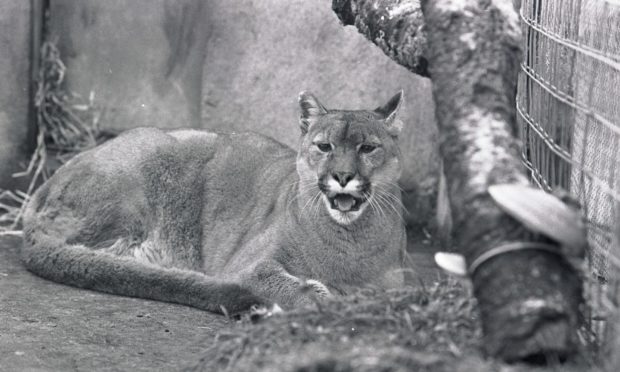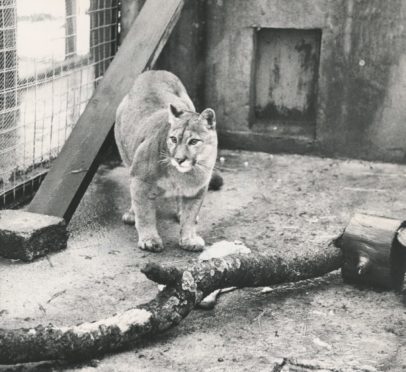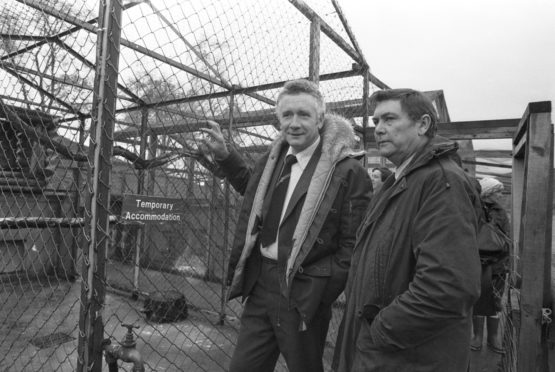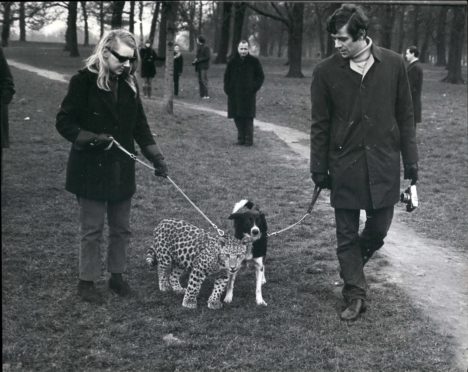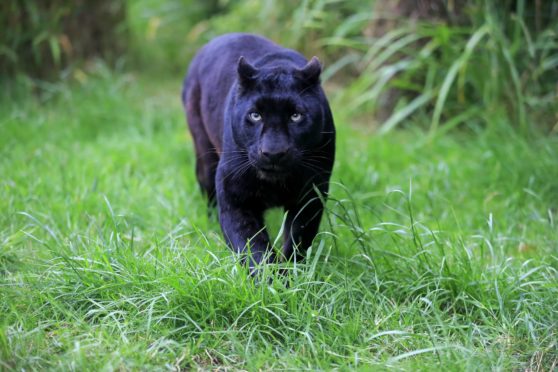She was the ‘wild’ puma who became a celebrity after being captured in the Highlands 40 years ago.
Felicity, as she came to be named, had been roaming the countryside in Cannich before being caught two years after farmers in the area started reporting a spate of attacks on their sheep.
There had been mystery animal sightings in the Highlands going back to 1927 when a lynx nicknamed the ‘Tiger of the North’ was caught in a trap set by a farmer after sheep and goats were attacked in the wild mountain districts of Inverness-shire.
Ted Noble
It was reported in 1977 that a man and his nephew at Farr, 10 miles from Inverness, “saw a lioness and two cubs” in a field and the next day a similar sighting was recorded at Culduthel.
However, matters came to a head in October 1980 after farmer Ted Noble took matters into his own hands following a continued unexplained loss of livestock for over a year.
Ted saw what he described as a “lioness or similar member of the big cat family” stalking ponies at his farm near Cannich.
Police searched in vain for the ‘lioness’ with the help of big-game expert Eric Stephens who said a lion could easily be living in the area where there were sheep, horses and deer because there was plenty of food and plenty of cover.
Ted continued to find the carcasses of farm animals, mainly sheep, mutilated and with their bones crushed.
The mystery beast had been sighted a number of times by other local people and eventually he decided to set a trap after becoming frustrated by police reluctance to make a further search.
Last laugh
The animal was enticed to a cage by a sheep’s head dangling from a rope at the entrance to the trap.
The captured puma made national news with one headline proclaiming: ‘Grrr-eat Scot! Farmer Ted Catches the Loch Ness Lion!’
“People were beginning to think I was nuts the way I was so obsessed with capturing this animal,” said Ted.
“But I have had the last laugh.
“I am pleased to have caught it but I am sad to have deprived it of a grand life.
“However, it was a destructive animal having killed sheep and ponies in the area and I had to end its freedom.”
Ted was aided in his successful trapping operation by Ian Graham, a senior inspector for the Scottish Society for the Protection of Cruelty to Animals, and by Janet Chisolm, a neighbouring farmer of nearby Tomich.
He also had advice on the correct methods to use from a retired Colonel who, in his younger days, had been a big game hunter in Africa.
The director of the Highland Wildlife Park at Kincraig, Eddie Orbell, confirmed the animal was a puma but his conclusion was that the big cat seemed too tame and too well fed to have been living wild.
He believed Felicity had been hand-reared as a cub and had been kept as a pet.
The origin of the puma was unclear but she even allowed experts who examined her to pet her behind her ears.
Overweight
Grantown vet George Rafferty undertook a close examination of Felicity after she was given treatment for a paw complaint.
“I was very surprised to find that the animal weighed 36 kilos – approximately 80lbs,” he said.
“This is definitely overweight for a female puma.
“I examined its teeth and found it has some incisors missing at the front, which is not unusual for an animal of its age.
“Its teeth are in remarkably good condition, although yellow with age. There is no tarter on them which suggests it has been living on a natural diet, as opposed to processed food.
“It has certainly spent most of its life in captivity.
“If it has been living rough I do not think it has been doing so for very long because of its bodily condition.
“There is also no doubt it has been used to contact with humans and is very well behaved.
“It loves to have its ears tickled and comes straight over to the bars of its cage when you approach.
“In fact we had great difficulty persuading it to go far enough away from us to fire a tranquiliser dart into it without doing any damage.”
Hoax
People soon began talking about a hoax and it was reported soon after Felicity’s capture that some eyewitnesses had seen a puma in a cage being driven around the area in a pick-up truck, although this could have been prior to the animal’s release.
Ted denied there had been a hoax and he was supported by Bob High from the Farmers’ Union who said that many farmers in the eastern Highlands had seen the animal, or lost livestock to it, but were afraid to speak out in case they were ridiculed.
Additional support came from Dr Hans Kruuk from the Institute of Terrestrial Ecology at Banchory, who analysed her faeces in the first hours of captivity which showed that Felicity had recently fed on deer, rabbit and sheep, suggesting that despite her advanced age and tameness she had indeed been hunting and surviving independently in the wild for some time.
The big cat sightings and livestock losses continued following Felicity’s capture and later a man wrote to Ted from a prison cell in England, confessing that he had liberated several big cats in the Glen Affric area after driving them up from south of the Border.
During the 1960s and 1970s it was perfectly legal in the UK to keep exotic animals as household pets, which ranged from leopards, pumas and panthers, to crocodiles and poisonous snakes.
In 1976 the UK Government introduced tougher new licensing rules over the keeping of wild animals without a licence.
Given the choice of acquiring a costly licence or relinquishing their pets to animal sanctuaries, rumours started that some owners chose a third option, which was sending cats out into the wild.
Further twist
The great Highland puma puzzle took a further twist three weeks after the capture as scientists in Banchory revealed strong evidence of another mountain lion on the loose.
Special tests carried out on two sheep mauled on Garve farms in Ross-shire found they were killed either by a puma or some other big cat.
Felicity was a top tourist draw for the next four years at the Highland Wildlife Park, Kincraig, near Aviemore, until she died in February 1985.
After Felicity’s death, the puma was preserved by a taxidermist, and since then has been a prime exhibit at Inverness Museum.
‘Mystery predator’ at large prompted police investigation
Felicity the puma is often cited as evidence that there are non-native cats at large in the UK.
Sightings of big cats or photographs taken at a distance have fuelled theories about their presence for decades.
Police and government scientists worked together to try to identify a “mystery predator” that appeared to be at large in the far north.
Correspondence from the past two years between Police Scotland, Science and Advice for Scottish Agriculture (SASA) and other government-funded agencies was released after a freedom of information request.
Injured sheep
A police officer, whose name and title have been redacted, wrote to SASA in November 2018 asking for help in identifying a large paw print.
They wrote: “I’ve had lots of reports over the past three years of big cat sightings and activity on the north coast, mainly in the Bettyhill area of Sutherland.
“There have been sightings of a large feline and a lot of dead or injured sheep.
“On one occasion I was present when a ewe was brought in off the hill with two puncture marks on the front of her right shoulder and two at the back of it.
“The wounds were over three inches apart, while some of the recent carcasses have very large puncture marks.”
The officer conceded that it was a “very controversial topic” but added: “Some crofters say there have always been very big feral cats in this area. I’m told there is a photograph of one shot, years ago, which was over four feet long.
“We definitely have a wild cat population as well; I’ve seen one myself. We don’t have many domestic cats in the area; there is a very sparse human population and miles of unoccupied land.”
The officer sent images of a paw print and one of a “recent kill”, writing: “The carcass was stripped clean, down to the spine/skull.”
The response from the SASA was inconclusive. They replied: “I’m not sure about the footprint. It does look a bit like a feline print but is also reminiscent of a fox or a dog.”
The investigation was closed last year.
